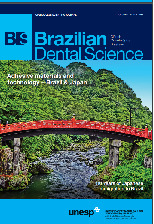In vitro analysis of dental ceramics: evaluation of the radiopacity and chemical composition by raman spectroscopy
DOI:
https://doi.org/10.14295/bds.2018.v21i2.1504Resumo
Objective: This study compared the radiopacity of different ceramic systems by means of digital radiographs and evaluate the chemical composition of the samples by Raman spectroscopy. Material and Methods: The hypothesis tested was that there was a difference in radiopacity among the tested materials. Specimens were prepared for each ceramic tested: FLD - VM7 (VITA Zahnfabrik), LD - IPS Empress e.max Press (IPS Empress), AL - In Ceram Alumina (VITA Zahnfabrik), ALYZ - In Ceram Zirconia (VITA Zahnfabrik), YZ - Lava All Ceram (3M/ESPE), and MYZ - Zirconzahn (Talladium Brazil). The specimens were radiographed and submitted to radiographic density readings using a histogram tool. The spectrometer coupled to a petrographic microscope was used for Raman spectroscopy measurements. Analysis of variance (ANOVA) and a Tukey post-hoc test were used to compare radiopacity of the different materials. Results: For all tested materials, the radiopacity showed statistically significant differences, except YZ and MYZ. Lava All Ceram and ZirkonZahn had high radiopacity values and VM7 and IPS Empress e.max Press showed lower radiopacity than human dental structures. Conclusion: It was possible to conclude that radiopacity is closely linked to ceramic chemical composition.
Keywords
Dental ceramics; Radiopacity; Raman spectroscopy test; Restorative dentistry.
Downloads
Downloads
Publicado
Como Citar
Edição
Seção
Licença
TRANSFERÊNCIA DE DIREITOS AUTORAIS E DECLARAÇÃO DE RESPONSABILIDADE
Toda a propriedade de direitos autorais do artigo "____________________________________________________________________" é transferido do autor(es) para a CIÊNCIA ODONTOLÓGICA BRASILEIRA, no caso do trabalho ser publicado. O artigo não foi publicado em outro lugar e não foi submetido simultaneamente para publicação em outra revista.
Vimos por meio deste, atestar que trabalho é original e não apresenta dados manipulados, fraude ou plágio. Fizemos contribuição científica significativa para o estudo e estamos cientes dos dados apresentados e de acordo com a versão final do artigo. Assumimos total responsabilidade pelos aspectos éticos do estudo.
Este texto deve ser impresso e assinado por todos os autores. A versão digitalizada deverá ser apresentada como arquivo suplementar durante o processo de submissão.




























